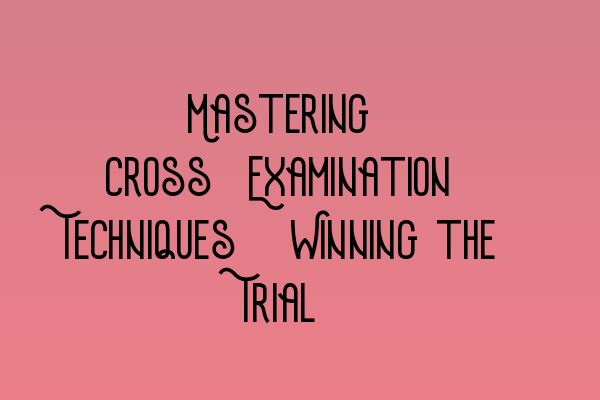Mastering Cross-Examination Techniques: Winning the Trial
When it comes to criminal law trials, mastering cross-examination techniques is crucial for winning the case. Cross-examination is the process of questioning a witness called by the opposing party in order to challenge their testimony and credibility. It is an art that requires strategic planning, effective communication, and quick thinking.
Whether you are preparing for the SQE 1 or SQE 2 exams or looking to enhance your legal skills in practice, understanding and implementing effective cross-examination techniques can significantly improve your chances of success.
1. Preparation is Key
Before stepping into the courtroom, thorough preparation is essential. Start by reviewing all the relevant case law, statutes, and documents related to your case. Familiarize yourself with the witness statements and evidence against your client. This will help you identify any weaknesses, inconsistencies, or contradictions that can be exposed during cross-examination.
Additionally, consider the specific areas you want to explore during cross-examination. Craft a detailed outline of questions to ask the witness, focusing on eliciting favorable answers or damaging the credibility of the opposing party’s case. Being well-prepared will not only boost your confidence but also allow you to seize the crucial moments during the trial.
2. Establishing Control and Building Rapport
As the cross-examiner, it’s crucial to establish control over the witness from the beginning. Maintain an authoritative but respectful tone, and be aware of your body language. Confidence and professionalism will help you gain credibility in the eyes of the judge and jury.
Building rapport with the witness is equally important. Use open-ended questions to encourage them to provide detailed answers. Active listening skills are crucial here, as they will help you identify any inconsistencies or opportunities to challenge their testimony effectively.
3. Leading Questions
Leading questions are your most powerful tool during cross-examination. These are questions that suggest the desired answer and limit the witness’s ability to provide lengthy or evasive responses. By strategically using leading questions, you can shape the narrative in your favor and control the direction of the witness’s testimony.
For example, rather than asking, “What happened on the night of the incident?” you could ask, “Isn’t it true that you were present at the scene when the alleged crime took place?” This effectively limits the witness’s response and allows you to control the information presented to the court.
4. Impeaching Witness Credibility
During cross-examination, it is essential to challenge the credibility of the opposing party’s witness, especially if their testimony is central to the case. Look for inconsistencies, contradictions, bias, or ulterior motives that can undermine their trustworthiness.
One effective technique is to confront the witness with prior statements or evidence that contradicts their current testimony. This allows you to expose any lies or inconsistencies and portray the witness as less reliable in the eyes of the jury.
5. Controlled Aggression and Emotional Intelligence
Cross-examination can be an intense, high-pressure situation, but maintaining composure is crucial. Controlled aggression can help you unsettle the witness and elicit valuable information, but it should be used strategically and sparingly. Know when to push harder and when to back off, depending on the witness’s response and the overall dynamics of the trial.
Emotional intelligence is also critical during cross-examination. Reading the witness’s emotions, body language, and non-verbal cues can help you identify potential weaknesses or inconsistencies. Adjust your tactics accordingly, empathizing when necessary and pressing harder when needed.
Conclusion
Mastering cross-examination techniques is a fundamental skill for any criminal law practitioner. It requires a combination of meticulous preparation, effective communication, strategic thinking, and the ability to think on your feet. By incorporating the techniques discussed above, you can significantly improve your chances of winning the trial and securing a favorable outcome for your clients.
